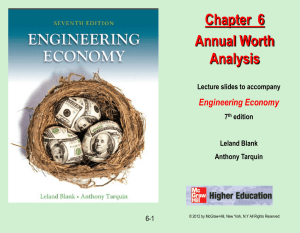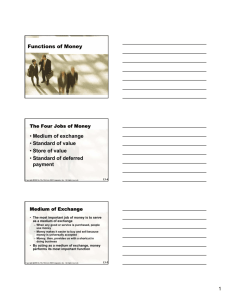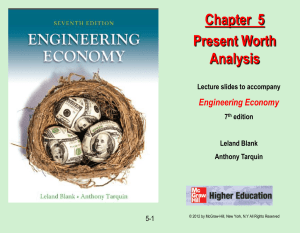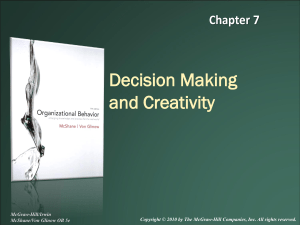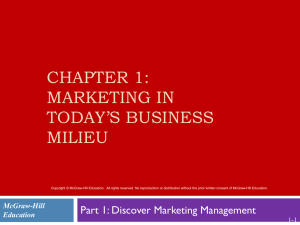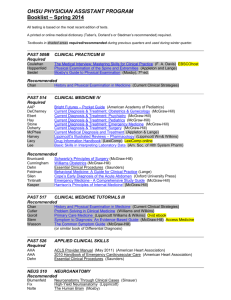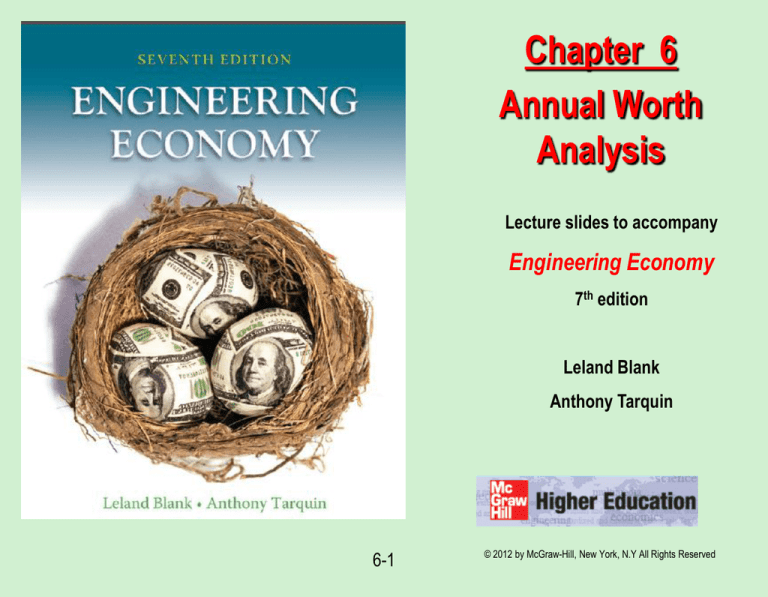
Chapter 6
Annual Worth
Analysis
Lecture slides to accompany
Engineering Economy
7th edition
Leland Blank
Anthony Tarquin
6-1
© 2012 by McGraw-Hill, New York, N.Y All Rights Reserved
LEARNING OUTCOMES
1. Advantages of AW
2. CR and AW values
3. AW analysis
4. Perpetual life
5. LCC analysis
6-2
© 2012 by McGraw-Hill, New York, N.Y All Rights Reserved
Advantages of AW Analysis
AW calculated for only one life cycle
Assumptions:
Services needed for at least the LCM of lives of alternatives
Selected alternative will be repeated in succeeding life cycles
in same manner as for the first life cycle
All cash flows will be same in every life cycle (i.e. will change
by only inflation or deflation rate)
6-3
© 2012 by McGraw-Hill, New York, N.Y All Rights Reserved
Capital Recovery and AW Values
Alternatives usually have the following cash flows:
Initial investment P - First cost of all assets
Salvage value S – Value of assets at end of useful life
Annual amount A – Cash flows associated with asset, such
as annual operating cost, M&O, etc.
General Equation: AW = CR + A
6-4
© 2012 by McGraw-Hill, New York, N.Y All Rights Reserved
Calculation of Annual Worth
An asset has a first cost of $20,000 , an annual operating
cost of $8000 and a salvage value of $5000 after 3 years.
Calculate the AW for one and two life cycles at i = 10%.
AWone = -20,000(A/P,10%,3) – 8000 + 5000(A/F,10%,3)
= -$14,532
AWtwo = -20,000(A/P,10%,6) – 8000 – 15,000(P/F,10%,3)(A/P,10%,6)
+ 5000(A/F,10%,6)
= -$14,532
Thus, the AW for one life cycle is the same for all life cycles!!
6-5
© 2012 by McGraw-Hill, New York, N.Y All Rights Reserved
Alternative Evaluation by AW
Not necessary to use LCM for different life alternatives
Select alternative with numerically largest AW
A company is considering two machines for a certain operation. Machine X
has a first cost = $30,000, AOC of $18,000, and S = $7000 after 4 years.
Machine Y will cost $50,000 with AOC of $16,000 and S = $9000 after
6 years. Which machine should the company select at an interest rate of
12% per year.
Solution:
AWX = -30,000(A/P,12%,4) –18,000 +7,000(A/F,12%,4)
= $-26,412
AWY = -50,000(A/P,12%,6) –16,000 + 9,000(A/F,12%,6)
= $-27,052
Select Machine X
6-6
© 2012 by McGraw-Hill, New York, N.Y All Rights Reserved
AW of Permanent Investment
Use A = Pi for infinite life alternatives
Find AW over one life cycle for finite life alternatives
Compare the alternatives below using AW and i = 10% per year
First Cost, $
Annual cost, $/year
Salvage value, $
Life, years
C
50,000
20,000
5,000
5
D
250,000
9,000
75,000
∞
Solution: AW = -50,000(A/P,10%,5) – 20,000 + 5,000(A/F,10%,5)
C
= $-32,371
AWD = -250,000(0.10) – 9,000
= $-34,000
6-7
Select alternative C
© 2012 by McGraw-Hill, New York, N.Y All Rights Reserved
Life-Cycle Cost Analysis
LCC analysis includes all costs for entire life cycle
Best when large percentage of costs are O & M
Includes phases of acquisition, operation, & phaseout
6-8
© 2012 by McGraw-Hill, New York, N.Y All Rights Reserved
Summary of Important Points
AW method converts all cash flows to annual value at MARR
Alternatives can be mutually exclusive, independent,
revenue, or service
AW comparison made for only one life cycle of each alt
For infinite life alts, annualize initial cost as P * i
Life-cycle cost analysis includes all costs of project
6-9
© 2012 by McGraw-Hill, New York, N.Y All Rights Reserved

